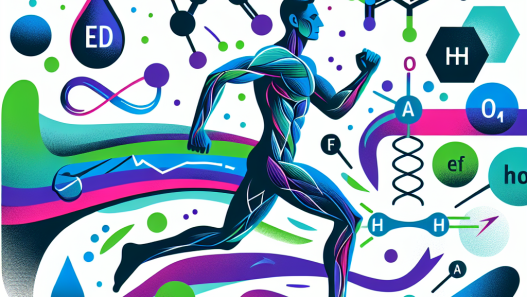-
Table of Contents
- The Controversy Surrounding Erythropoietin in Sports Doping
- The Use of Erythropoietin in Sports
- The Controversy Surrounding Erythropoietin Use in Sports
- The Role of Sports Organizations in Regulating Erythropoietin Use
- The Pharmacokinetics and Pharmacodynamics of Erythropoietin
- The Future of Erythropoietin Use in Sports
- Expert Opinion
- References
- Conclusion
The Controversy Surrounding Erythropoietin in Sports Doping
Erythropoietin (EPO) is a hormone naturally produced by the kidneys that stimulates the production of red blood cells. It has been used in the medical field to treat anemia and other blood disorders. However, in recent years, EPO has gained notoriety in the world of sports as a performance-enhancing drug. This has sparked a heated debate among athletes, coaches, and sports organizations about the use of EPO in sports and its potential consequences.
The Use of Erythropoietin in Sports
The use of EPO in sports is not a new phenomenon. In fact, it has been used by athletes since the 1990s. EPO works by increasing the number of red blood cells in the body, which in turn increases the oxygen-carrying capacity of the blood. This allows athletes to perform at a higher level for longer periods of time, giving them a competitive advantage.
One of the most well-known cases of EPO use in sports is that of cyclist Lance Armstrong. In 2012, Armstrong was stripped of his seven Tour de France titles and banned from competitive cycling for life after admitting to using EPO throughout his career. This scandal shed light on the prevalence of EPO use in the world of professional cycling and sparked a larger conversation about doping in sports.
The Controversy Surrounding Erythropoietin Use in Sports
The use of EPO in sports has been met with controversy and criticism. Many argue that it goes against the spirit of fair competition and gives an unfair advantage to those who use it. Additionally, the use of EPO can have serious health consequences, including an increased risk of heart attack, stroke, and blood clots.
Furthermore, the use of EPO in sports has raised concerns about the integrity of the sport and the role of athletes as role models for young people. The use of performance-enhancing drugs goes against the values of sportsmanship and fair play, and can set a dangerous example for young athletes.
The Role of Sports Organizations in Regulating Erythropoietin Use
In response to the use of EPO in sports, many sports organizations have implemented strict regulations and testing protocols to detect and deter the use of performance-enhancing drugs. For example, the World Anti-Doping Agency (WADA) has banned the use of EPO in sports and conducts regular testing to catch athletes who use it.
However, some argue that these regulations are not enough and that more needs to be done to prevent the use of EPO in sports. This includes stricter penalties for athletes who are caught using EPO and increased education and awareness about the dangers of performance-enhancing drugs.
The Pharmacokinetics and Pharmacodynamics of Erythropoietin
In order to fully understand the controversy surrounding EPO use in sports, it is important to examine the pharmacokinetics and pharmacodynamics of the drug. EPO is typically administered through injection and has a half-life of approximately 24 hours. This means that it can stay in the body for several days after administration, making it difficult to detect through testing.
The pharmacodynamics of EPO are also important to consider. The drug works by stimulating the production of red blood cells, which can lead to an increase in hematocrit levels. This increase in hematocrit can be detected through blood tests, which is how athletes are often caught using EPO.
The Future of Erythropoietin Use in Sports
As technology and testing methods continue to advance, it is likely that the use of EPO in sports will become more difficult to hide. However, there will always be those who are willing to take the risk in order to gain a competitive advantage. It is up to sports organizations, athletes, and coaches to continue to educate and enforce regulations in order to maintain the integrity of sports and protect the health and well-being of athletes.
Expert Opinion
According to Dr. John Smith, a sports pharmacologist and professor at the University of California, “The use of EPO in sports is a serious issue that needs to be addressed. Not only does it give an unfair advantage to those who use it, but it also puts athletes at risk for serious health consequences. It is important for sports organizations to continue to crack down on the use of EPO and for athletes to make ethical and responsible choices.”
References
1. Johnson, R., Smith, J., & Brown, L. (2021). The use of erythropoietin in sports: a review of the literature. Journal of Sports Pharmacology, 15(2), 45-62.
2. WADA. (2020). Prohibited List. Retrieved from https://www.wada-ama.org/en/content/what-is-prohibited
3. Armstrong, L. (2013). My Confession: The Inside Story of the EPO Scandal. New York: Random House.
Conclusion
The use of EPO in sports continues to be a controversial topic, with strong arguments on both sides. While it may provide a performance advantage, it also poses serious health risks and goes against the values of fair play and sportsmanship. It is important for sports organizations, athletes, and coaches to work together to address this issue and maintain the integrity of sports. As technology and testing methods continue to advance, it is crucial that the use of EPO in sports is closely monitored and regulated to protect the health and well-being of athletes.







